Italian Ricotta Parmesan Bread
This Homemade Italian Bread is made with Ricotta and Parmesan cheese which gives it a soft and flavourful crumb. Perfect as an accompaniment with dinner or why not use it as a sandwich bread or even toasted? Easy and delicious!
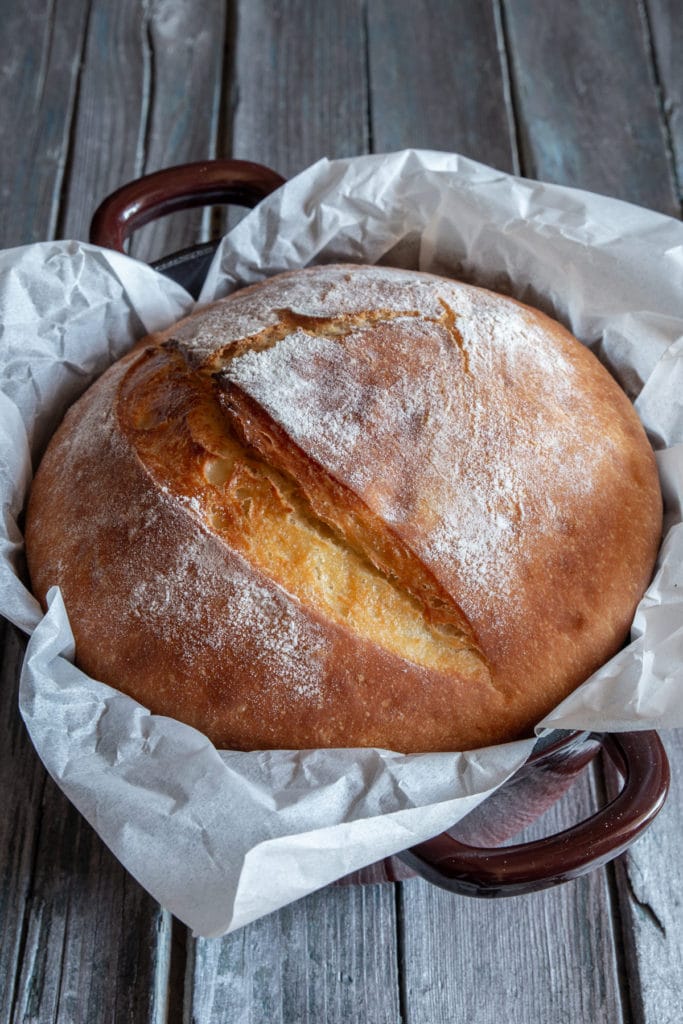
What are the ingredients?
- Flour: I usually use all purpose or bread flour, you will need a flour that has at least 12% protein. Bread flour will produce a chewier crust.
- Water: Is necessary for yeast fermentation and reproduction.
- Parmesan Cheese: Adds flavour and is delicious mixed with ricotta cheese.
- Olive Oil: Will help tenderize the bread.
- Ricotta Cheese: This will help the dough with flavour, softness of the crust and adding a bit of moisture.
- Active dry yeast: You need yeast for the dough to rise.
- Salt: Helps to give the bread flavour.
What is Italian Bread
Italian bread usually contains olive oil and sometimes salt and milk. For this recipe if you want a richer dough with some added nutrients and a crust that is softer, then you can substitute anywhere from 1/4 of the water to 1/2 with milk. I wanted a firmer crumb and crust so I used just water.
Different types of Italian Bread
Apparently there are over 250 different types of bread in Italy that are actually made today. I certainly haven’t tried even close to that many, but a few of are favourites are a Ciabatta, Genzano, Lariano and the Italian can never pass up a Cazzottini or two.
How to make it
In the stand up mixer add the water and sprinkle the yeast on top, let it sit for about 10 minutes, then stir, add the flour, ricotta, parmesan, olive oil and salt on top. Start to knead on low speed for a couple of minutes then increase the speed and continue to knead until the dough is soft and elastic.

Move the dough to a lightly floured flat surface and stretch and fold a few times, shape into a ball.

Place the dough in a lightly oiled bowl, rolling the dough to cover lightly in the oil, cover the dough and place in a warm draft free area to rise until doubled in bulk.

Move the dough to a lightly floured flat surface, shape into desired shape, log or boule, place in a dutch oven or oven safe covered casserole pot, sprinkle with flour , cover with plastic and let rise 1 hour.

Once the dough has risen, you can score it or even leaf as is, bake, then immediately move the baked loaf to a wire rack to cool completely before serving.
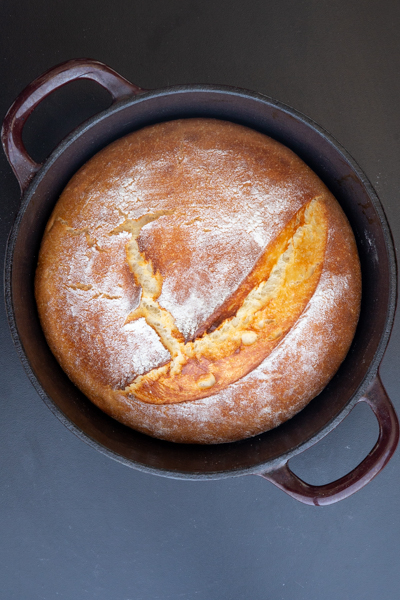
What is ricotta cheese?
Ricotta cheese is made from leftover whey from other cheeses, it can be from cow, goat, sheep or Italian Buffalo. Sometimes an acidifier is added. Ricotta meaning recooked is just that, the recooking of the whey. Since it is not produced from curd, but from whey, ricotta cannot be considered a real cheese. The term ricotta can also mean the fresh one.
Fresh ricotta is placed in the typical cone shaped perforated container, where it is left to drain. It is usually a white colour, of course how white depends on the type of milk that is used. It is soft and slightly grainy but is not elastic or hard. Fresh ricotta has the smell of warm milk and hay, although the aroma of hay will be more intense in ricotta that is made from sheep or buffalo milk.
Most if not all the regions of Italy make their own ricotta but the most popular comes from Lazio, Abruzzo, Basilicata, Sicilia, Sardegna, Campania, Puglia, Calabria, Toscana, Friuli-Venezia Giulia, Lombardia e Piemonte. And Baked Ricotta is originally from the Region of Sardegna.
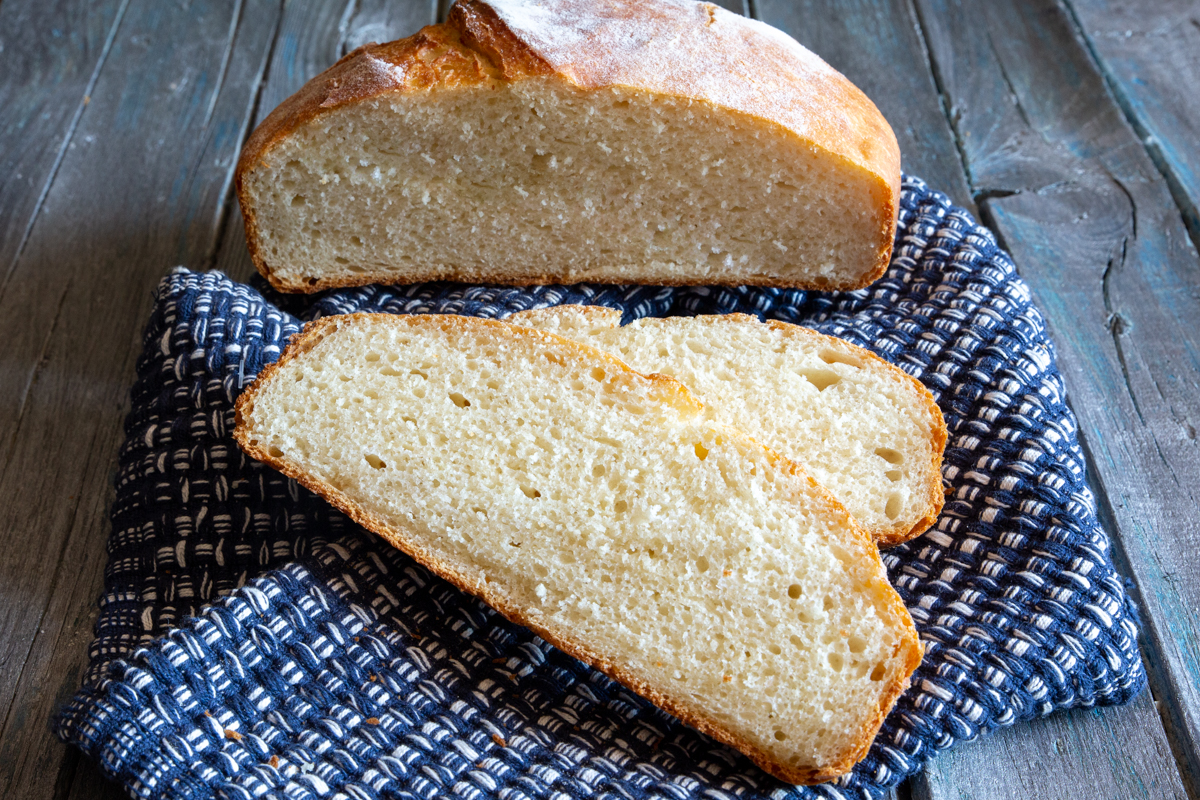
Make sure your Yeast is active
- To start make sure your yeast is active,
- In a small bowl add the water, make sure it is lukewarm (if it is too warm it will kill the yeast), then add a pinch of sugar to the water.
- Sprinkle the yeast over the top, stir to combine, then let it rest for about 5 minutes.
- If the yeast is active it will dissolve in the water and the mixture will bubble.
What can I use instead of a dutch oven?
If you don’t have a dutch oven then you can use any oven safe pot or deep pan with a lid, make sure it will stand up to 450F (250C) before using. Because this is a softer dough, using a pot or dutch oven helps the dough keep it’s shape.
There really is no need to heat the pot first while the oven is pre-heating. I let the 2nd rise happen in the pot and then bake. I also don’t add parchment paper because I find it creases the dough while it bakes, just lightly oil the pot before placing the dough inside. Cover and bake.
How to tell if the bread is over proofed
Bread that is over proofed is dough that has risen too long, the air bubbles have popped. To check to see if your dough is over proofed, just poke it with your finger and if doesn’t spring back at all, it is has over proofed. To save it, just stretch and fold the dough to remove any gas, reshape and let rise again.
How to tell when bread is done
You can tell bread is done when you tap on the bottom of the loaf and there is a hollow sound, but if you want to be 100 percent sure, then using a thermometer is your best best, the bread is baked when the centre of the loaf registers 200 to 210 degrees.
What else can I use ricotta bread for?
- Breadcrumbs: Then use those for meatballs!
- French toast: Any kind of toast, really.
- Bruschetta – If you have leftover ricotta, make a herb and ricotta bruschetta.
- Sandwiches – Whether sliced or as a side, this bread is perfect for your favourite fillings or plain.

Recipe FAQ’s
Yes it can, mix in a large mixing bowl then move to a lightly floured flat surface and knead until the dough is soft and elastic, approximately 15-20 minutes. Continue with the recipe.
The first rise can be done in the fridge, place the bowl in the fridge and let rise for 8-12 hours, bring the dough to room temperature (about an hour) and continue with the recipe.
I personally use all purpose but if you prefer bread flour works just as well, some people swear by it. It will give your dough a chewier and denser bread. Make sure your flour has at least 12% protein.
Cool the bread completely, then store it in a plastic airtight bag, storage container, wrap in foil or the Italian way and, place the loaf in a paper bag then place it in a plastic bag and close tightly. It can be kept at room temperature for about two to three days. Never refrigerate bread, it will make it dry and stale.
Yes you can freeze it, let the loaf cool completely, then you can either slice it or leave it whole. Be sure to wrap tightly with foil or freezer safe wrap and then place it in a freezer safe bag or container. Properly stored, it will last for about 3 months in the freezer.
More delicious Bread Recipes to try
- Rustic Italian Bread with Lievito Madre
- Traditional Italian Ciabatta Bread
- Homemade Italian Bread
- Soft Potato Focaccia Bread
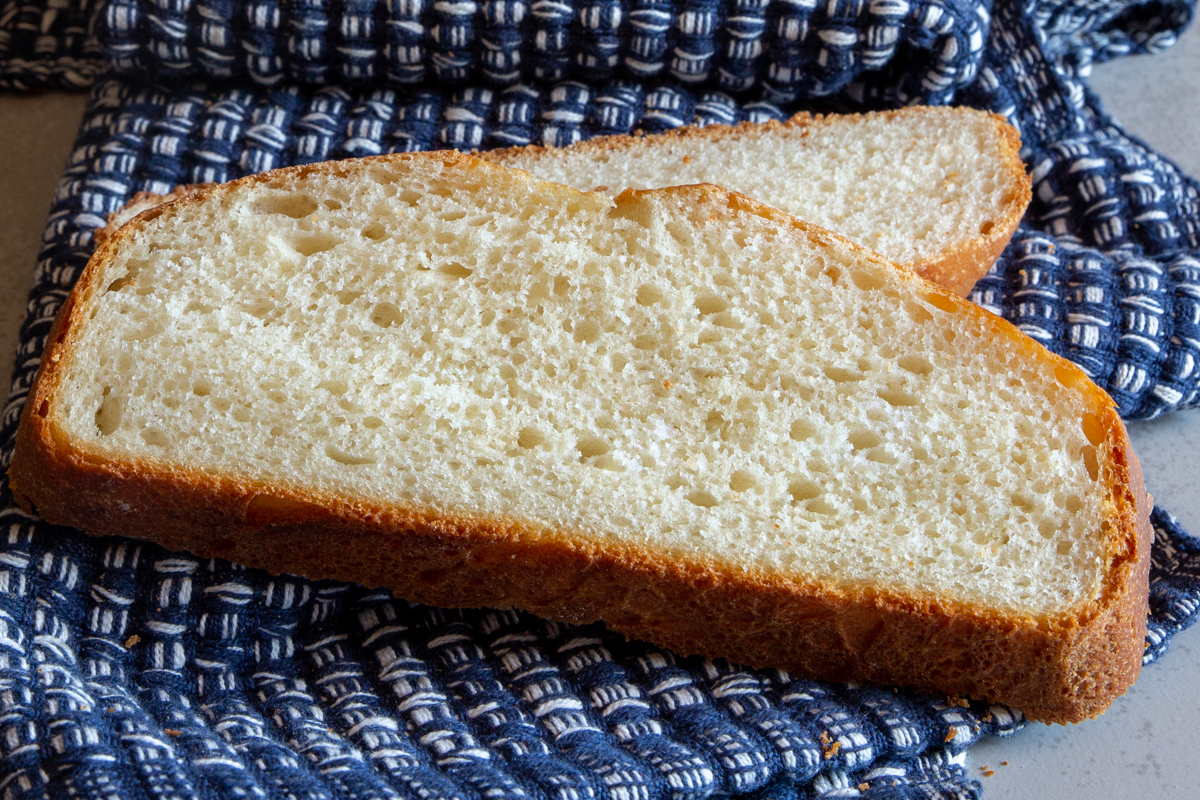
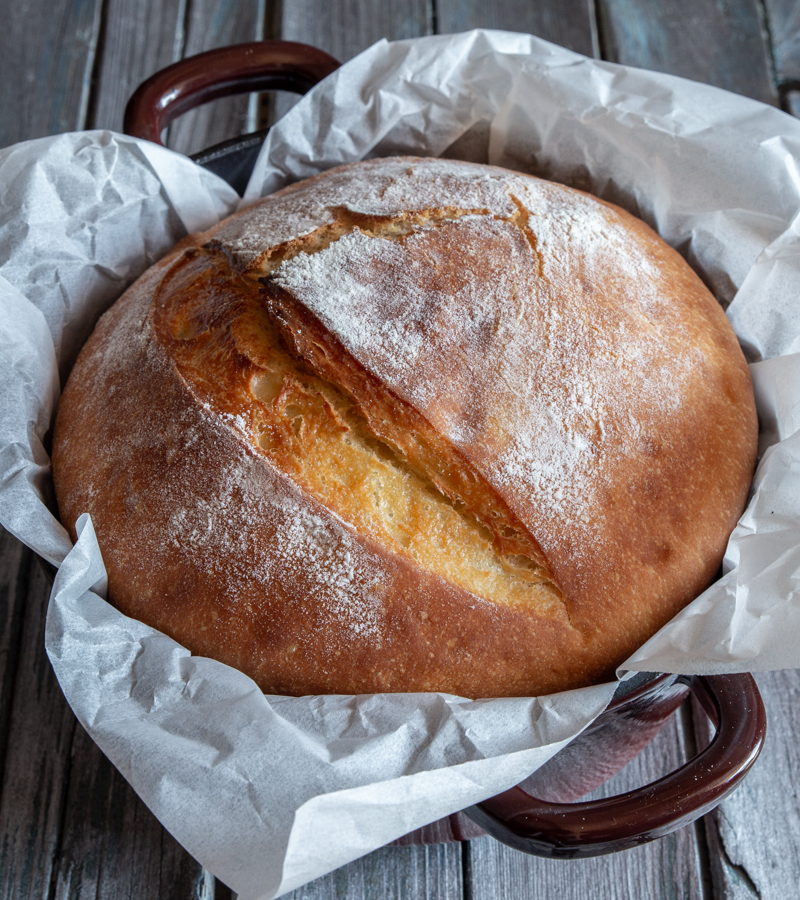
Italian Ricotta Parmesan Bread
Ingredients
- ½ cup + 2 tablespoons lukewarm water (150 grams)
- 1 teaspoon active dry yeast
- 2¼ cups + 1 tablespoon all purpose or bread flour (at least 12% protein) (300 grams)
- 3 tablespoons freshly grated parmesan cheese
- 1½ tablespoons olive oil
- ⅓ cup + 1 tablespoon ricotta cheese (100 grams)
- 1 teaspoon salt
Instructions
- In the stand up mixer add the water and sprinkle the yeast on top, let it sit for about 10 minutes, then stir, add the flour, ricotta, parmesan, olive oil and salt on top. Start to knead on low speed #1 for about 1-2 minutes then increase the speed #2 and continue until the dough is soft and elastic, 6-8 minutes.
- Move the dough to a lightly floured flat surface and stretch and fold a few times, shape into a ball. Place the dough in a lightly oiled bowl, rolling the dough to cover lightly in oil, cover the bowl and place in a warm draft free area to rise until doubled in bulk, approximately 2 hours.
- Move the dough to a lightly floured flat surface, shape into desired shape, log or boule, place in a lightly oiled* dutch oven or oven safe covered casserole dish, sprinkle the top with flour (use rice or semolina if you don't have it then all purpose or bread will work, cover with plastic and let rise 1 hour.
- Pre-heat oven to 400F (200C).
- Score the bread, then place the covered pot in the oven and bake, for 25-30 minutes, remove the lid and continue to bake for 10-15 minutes or until the loaf is done. Immediately move the baked loaf to a wire rack to cool completely before serving. Enjoy!
I haven’t made this yet but I’ve got some ricotta I want to use up. Can I make the dough & freeze it to bake at a later time ?
Hi Jenny, yes you can freeze it, be sure to freeze it after the first rise. Hope that helps. Take care!
Hello, Rosemary
Can this recipe be made in a bread machine? What is the weight of the loaf made by the smallest (“1x”) version?
Hi Deborah, I really don’t know I have never used a bread machine, and I did not weight bread, I used a 20cm / 8 inch dutch oven to bake it. 🙂
Thanks, anyway. I’ll give it a try because I’m curious (and bread machines always do a better job of it than I do). From the look of the recipe amounts, and your 8-inch dutch oven, I think using the cycle for the 1.5 lbs loaf might be best. Maybe I’ll be able to do it after Thanksgiving.
Hi Deborah, to tell the truth I received a bread machine so many years ago and it’s sitting upstairs, now you are giving me the idea of bringing it down and giving it a try. 🙂 Let me know how it goes if you try it. Take care and have a wonderful Thanksgiving!
Did you try it in the bread machine? I’m thinking of trying the dough cycle and then Dutch oven
Easy to follow directions.
Delicious!
Will make again.
Hi Susan, thanks so much glad you liked it, take care!
Rosemary, just for educational purposes-whats your best suggestion to rescue a recipe if you do realize that a dough was over proofed? Is there anything or an alternate plan to help to use that dough?
Hi Dee, if you over proof the dough, you should gently knead it a few times, reshape it and let it rise again. It should bake up fine. Let me know. Take care!